Home Appliances Market Size
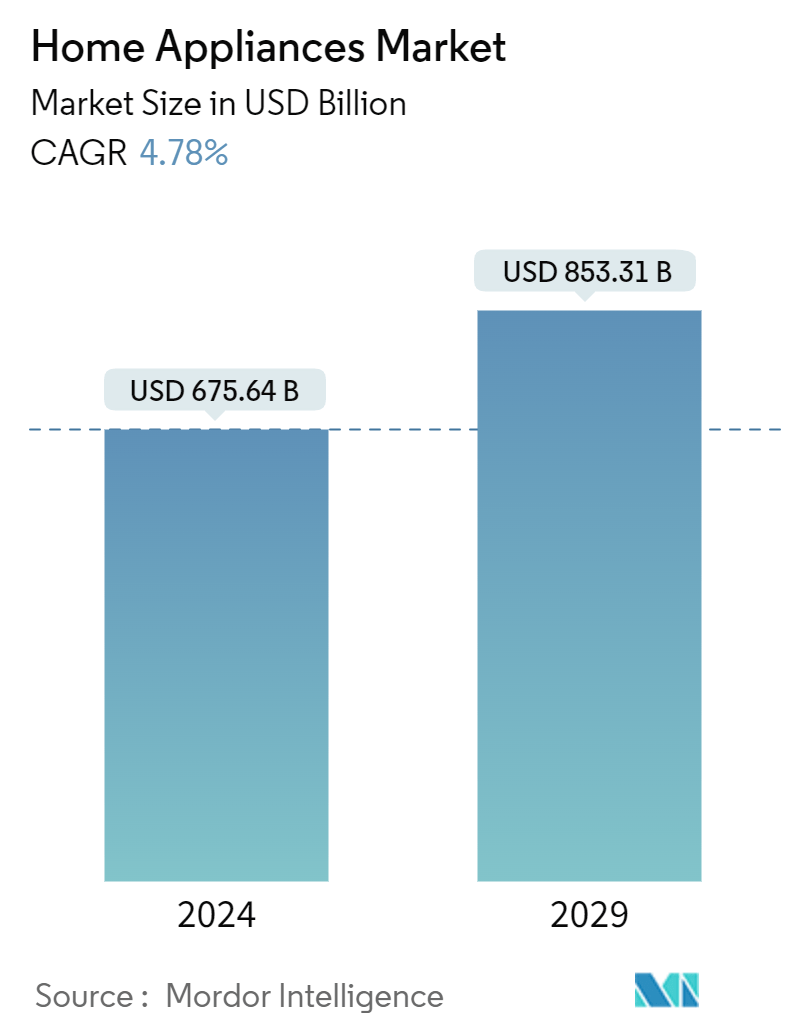
| Study Period | 2020 - 2029 |
| Market Size (2024) | USD 675.64 Billion |
| Market Size (2029) | USD 853.31 Billion |
| CAGR (2024 - 2029) | 4.78 % |
| Fastest Growing Market | North America |
| Largest Market | Asia Pacific |
Major Players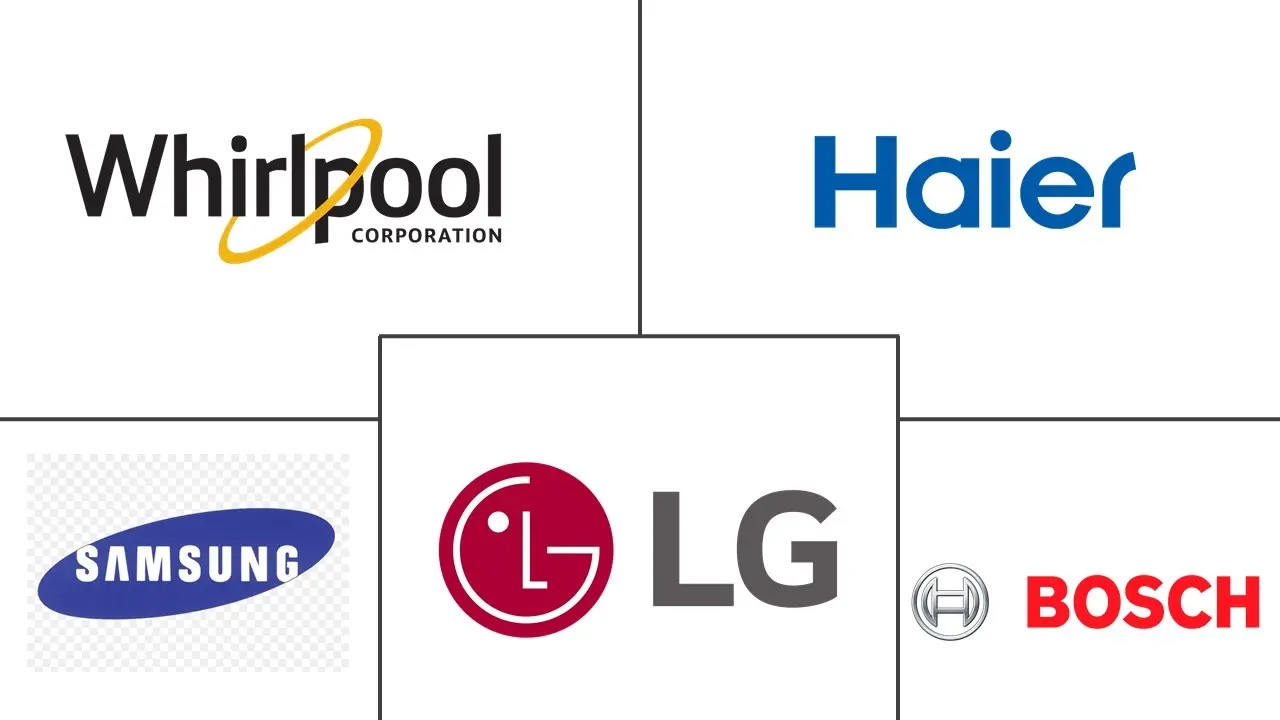
*Disclaimer: Major Players sorted in no particular order |
Home Appliances Market Analysis
The Home Appliances Market size is estimated at USD 675.64 billion in 2024, and is expected to reach USD 853.31 billion by 2029, at a CAGR of 4.78% during the forecast period (2024-2029).
The home appliance market has experienced consistent growth in recent years and is expected to maintain this upward trajectory in the next decade. The transition from traditional to smart home appliances is seen as a revolutionary development in the home appliance sector. The primary drivers of the market are a rise in per capita income, a shift in consumer lifestyle, and an increasing number of smaller homes. Moreover, customer preference for eco-friendly and energy-efficient appliances drives market expansion. Furthermore, factors such as government programs for energy-efficient appliances in the world are likely to boost energy-efficient appliance adoption in the coming years.
Consumers have grown more tech-savvy as a result of increased digitization, and they are well-versed in the usage and advantages of all modern products. With technological advancement, the number of smart appliances launched on the market has gradually grown. The growth of smart appliances, which can be connected to a smartphone and monitored remotely, is being aided by the rise of smart homes and smartphones.
Manufacturers of wireless technologies, such as Wi-Fi and Bluetooth, leverage connection as a distinctive feature that may be employed in or accessible by smartphones and tablets. Yet, manufacturers are attracting tech-savvy consumers by incorporating this technology into residential home appliances such as air conditioners, refrigerators, ovens, washing machines, and other appliances. The enhancement of network infrastructure has led to improved broadband and internet accessibility. As a result, consumers are increasingly selecting wireless and technologically advanced products, primarily due to the convenience they provide. The affordability of white goods ownership, especially in developing countries, also presents growth opportunities in the market. Additionally, an increase in replacement sales in developed regions is projected to boost market demand, which can be attributed to rising per capita income and rapid urbanization.
Home Appliances Market Trends
Rising Urbanization Will Propel The Small Home Appliances Market
The small home appliances market is projected to experience substantial growth in the coming years, driven by an increase in consumer spending. This rise in spending can be attributed to the growth of disposable incomes and urbanization. Urbanization has brought about changes in both work and living practices, as well as the development of organized retail sectors. As a result, many developing countries are expected to undergo rapid urbanization and witness a rise in spending power, leading to a surge in demand for small home appliances. Urban residents are expected to adopt these appliances at higher rates, contributing significantly to the market's growth. The demand for small appliances such as coffee makers, food processors, and egg cookers has already fuelled the expansion of the small domestic appliances market. Additionally, the urbanization of the population is anticipated to boost the sales of major smart appliances, including high-end ones. The market will also be further augmented by the growth of small kitchen appliances. Consumers are increasingly seeking value-added products that offer convenience and affordability. This has led to a significant change in the decision-making process prior to purchase due to changing consumer preferences. Furthermore, the increasing popularity of online sales and discounted prices has led to a surge in the purchase of small appliances.
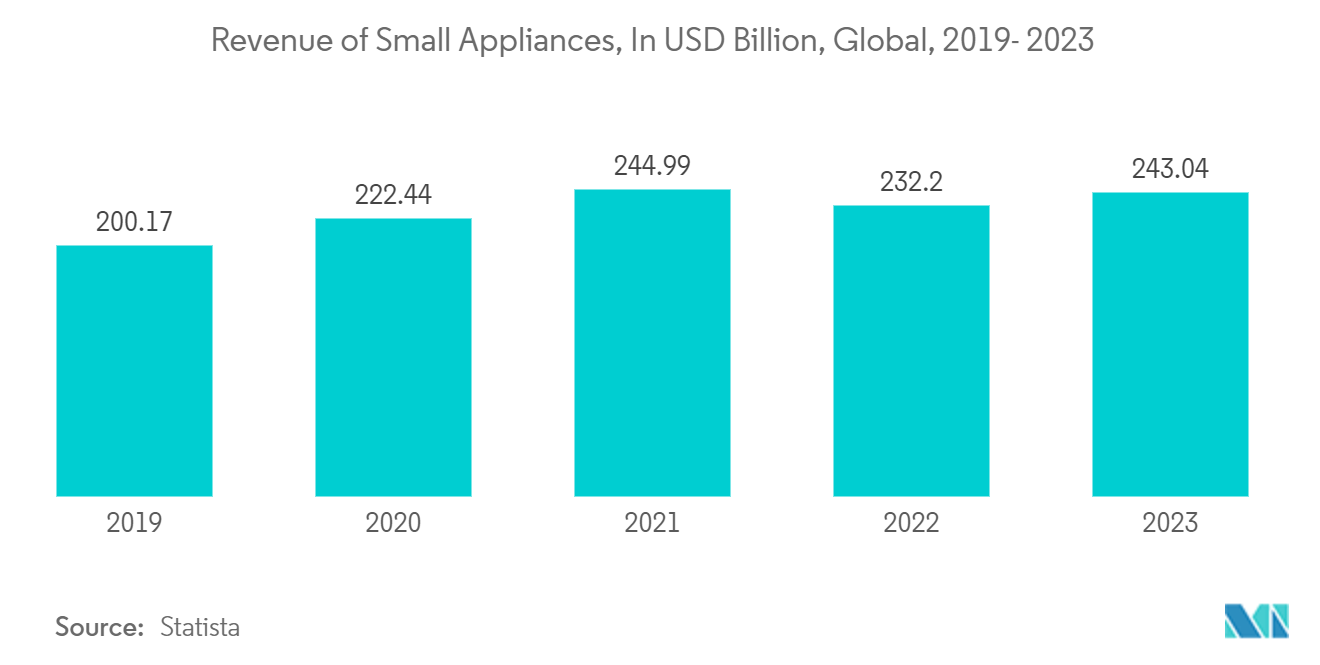
Asia-Pacific is Dominating the Home Appliances Market
The Asia-Pacific region is poised to lead the market in the projected period. The region's expanding population and urbanization, along with the surge in construction activities for both commercial and residential buildings in countries like India, China, Japan, South Korea, and Bangladesh, among others, have driven the demand for household appliances. Additionally, the emergence of local players offering affordable appliance products is anticipated to further stimulate market growth. Moreover, prominent regional brands such as Haier, Midea, Gree, Hisense from China, Samsung, LG from Korea, Panasonic, Sharp, Hitachi from Japan, and Videocon from India hold a significant market share in the home appliances sector in the Asia-Pacific region. The smart appliances market in Asia-Pacific is projected to witness substantial growth, with developed countries like Japan, Singapore, Hong Kong, and Indonesia expected to experience a rise in smart appliance sales due to factors like increasing energy and labor costs, strong consumer purchasing power, and growing awareness of smart cities and integrated appliances. Notably, China stands out with the highest demand for traditional air conditioners globally, driven by government initiatives promoting energy-efficient appliances, a booming real estate market, and the region's hot climate.
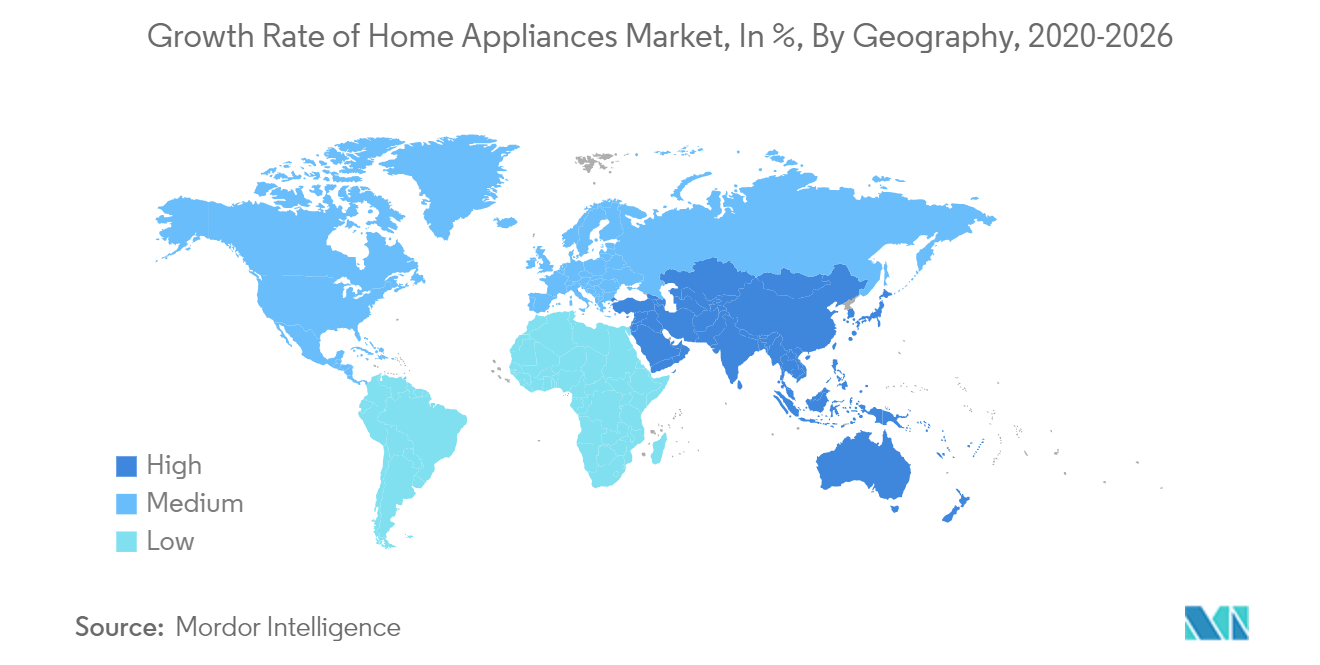
Home Appliances Industry Overview
The Home Appliance market is highly fragmented, with many players. In terms of market share, some major international players dominating the home appliances market are Whirlpool, Haier, Samsung Electronics, LG Electronics, and Bosch. However, smaller to medium-sized enterprises are increasing their market presence through securing new contracts and entering new markets as a result of technological progress and product innovation.
Home Appliances Market Leaders
-
Whirlpool
-
Haier
-
Samsung Electronics
-
LG Electronics
-
Bosch
*Disclaimer: Major Players sorted in no particular order
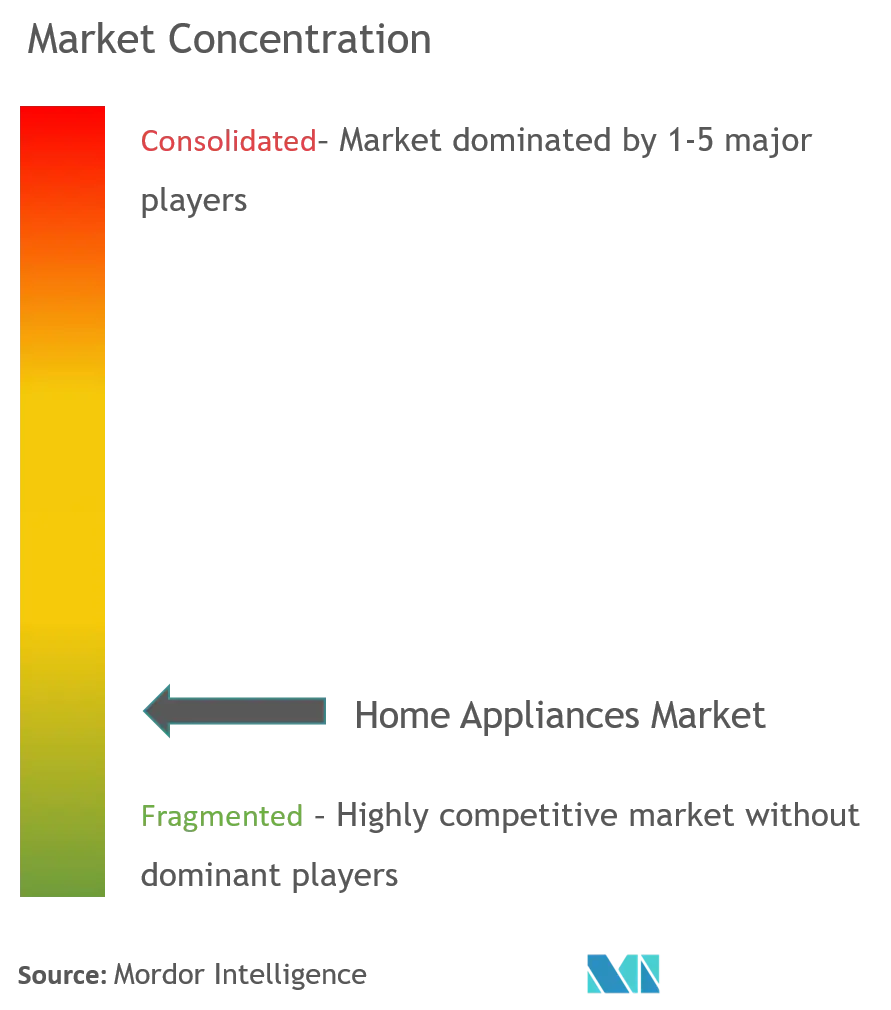
Home Appliances Market News
- February 2024: Panasonic unveiled its latest series of air conditioners for the year 2024, featuring a selection of room ACs equipped with Matter technology in India.
- January 2024: Bosch Home Appliances has unveiled the introduction of a fresh range of countertop Fully Automatic Espresso Machines. This remarkable line of products has been recognized as a CES 2024 Innovation Award Honoree in the smart home category.
Home Appliance Market Report - Table of Contents
1. INTRODUCTION
- 1.1 Study Assumptions and Market Definition
- 1.2 Scope of the Study
2. RESEARCH METHODOLOGY
3. EXECUTIVE SUMMARY
4. MARKET INSIGHTS AND DYNAMICS
- 4.1 Market Overview
-
4.2 Market Drivers
- 4.2.1 Increasing Adoption of Connected Home Appliances for Convenience and Automation
- 4.2.2 Growth in Disposable Income Levels and Consumer Spending
-
4.3 Market Restraints
- 4.3.1 Changing Consumer Preferences and Lifestyle Trends Influencing Demand for Certain Appliances
- 4.3.2 Regulatory Compliances Impedes Market Growth
-
4.4 Market Opportunities
- 4.4.1 Integration of Smart Home Technology, such as IoT and Voice Control, in Appliances
- 4.5 Value Chain/Supply Chain Analysis
-
4.6 Porter's Five Forces Analysis
- 4.6.1 Bargaining Power of Suppliers
- 4.6.2 Bargaining Power of Buyers/Consumers
- 4.6.3 Threat of New Entrants
- 4.6.4 Threat of Substitute Products
- 4.6.5 Intensity of Competitive Rivalry
- 4.7 Insights on Technological Advancements in the Market
- 4.8 Impact of COVID-19 on the Market
5. MARKET SEGMENTATION
-
5.1 By Product
- 5.1.1 Major Appliances
- 5.1.1.1 Refrigerators
- 5.1.1.2 Freezers
- 5.1.1.3 Dishwashing Machines
- 5.1.1.4 Washing Machines
- 5.1.1.5 Ovens
- 5.1.1.6 Air Conditioners
- 5.1.1.7 Other Major Appliances
- 5.1.2 Small Appliances
- 5.1.2.1 Coffee/Tea Makers
- 5.1.2.2 Food Processors
- 5.1.2.3 Grills and Roasters
- 5.1.2.4 Vacuum Cleaners
- 5.1.2.5 Other Small Appliances
-
5.2 By Distribution Channel
- 5.2.1 Multi-Branded Stores
- 5.2.2 Specialty Stores
- 5.2.3 Online
- 5.2.4 Other Distribution Channels
- 5.3 By Geography
-
5.4 North America
- 5.4.1 United States
- 5.4.2 Canada
- 5.4.3 Mexico
- 5.4.4 Rest of North America
-
5.5 Europe
- 5.5.1 United Kingdom
- 5.5.2 Germany
- 5.5.3 France
- 5.5.4 Russia
- 5.5.5 Italy
- 5.5.6 Spain
- 5.5.7 Rest of Europe
-
5.6 Asia-Pacific
- 5.6.1 India
- 5.6.2 China
- 5.6.3 Japan
- 5.6.4 Australia
- 5.6.5 Rest of Asia-Pacific
-
5.7 South America
- 5.7.1 Brazil
- 5.7.2 Argentina
- 5.7.3 Rest of South America
-
5.8 Middle East and Africa
- 5.8.1 United Arab Emirates
- 5.8.2 South Africa
- 5.8.3 Rest of Middle East and Africa
6. COMPETITIVE LANDSCAPE
-
6.1 Company Profiles
- 6.1.1 Haier
- 6.1.2 Whirlpool Corporation
- 6.1.3 Samsung Electronics
- 6.1.4 LG Electronics
- 6.1.5 Bosch
- 6.1.6 Sony
- 6.1.7 Midea
- 6.1.8 Electrolux
- 6.1.9 Philips
- 6.1.10 Panasonic Corporation*
- *List Not Exhaustive
7. FUTURE TRENDS
8. DISCLAIMER
** Subject To AvailablityHome Appliances Industry Segmentation
A household appliance is a domestic appliance, an electric appliance, or a home appliance, is a device that aids in household tasks like cooking, cleaning, and food preservation. The report provides a thorough examination of the home appliances market, encompassing an evaluation of national accounts, economic factors, and emerging trends within different segments. It also delves into the notable shifts in market dynamics and offers an overview of the market as a whole.
The home appliance market is segmented by product (major appliances (refrigerators, freezers, dishwashers, ovens, air conditioners, and other major appliances) and small appliances (coffee and tea makers, food processors, grills and roasters, vacuum cleaners, and other small appliances)), distribution channel (multi-branded stores, specialty stores, online, and other distribution channels), and geography (North America, South America, Europe, Asia-Pacific, and the Middle East and Africa). The report provides market size and value forecasts (in USD) for these segments.
| By Product | Major Appliances | Refrigerators |
| Freezers | ||
| Dishwashing Machines | ||
| Washing Machines | ||
| Ovens | ||
| Air Conditioners | ||
| Other Major Appliances | ||
| By Product | Small Appliances | Coffee/Tea Makers |
| Food Processors | ||
| Grills and Roasters | ||
| Vacuum Cleaners | ||
| Other Small Appliances | ||
| By Distribution Channel | Multi-Branded Stores | |
| Specialty Stores | ||
| Online | ||
| Other Distribution Channels | ||
| North America | United States | |
| Canada | ||
| Mexico | ||
| Rest of North America | ||
| Europe | United Kingdom | |
| Germany | ||
| France | ||
| Russia | ||
| Italy | ||
| Spain | ||
| Rest of Europe | ||
| Asia-Pacific | India | |
| China | ||
| Japan | ||
| Australia | ||
| Rest of Asia-Pacific | ||
| South America | Brazil | |
| Argentina | ||
| Rest of South America | ||
| Middle East and Africa | United Arab Emirates | |
| South Africa | ||
| Rest of Middle East and Africa |
Home Appliance Market Research FAQs
How big is the Home Appliances Market?
The Home Appliances Market size is expected to reach USD 675.64 billion in 2024 and grow at a CAGR of 4.78% to reach USD 853.31 billion by 2029.
What is the current Home Appliances Market size?
In 2024, the Home Appliances Market size is expected to reach USD 675.64 billion.
Who are the key players in Home Appliances Market?
Whirlpool, Haier, Samsung Electronics, LG Electronics and Bosch are the major companies operating in the Home Appliances Market.
Which is the fastest growing region in Home Appliances Market?
North America is estimated to grow at the highest CAGR over the forecast period (2024-2029).
Which region has the biggest share in Home Appliances Market?
In 2024, the Asia Pacific accounts for the largest market share in Home Appliances Market.
What years does this Home Appliances Market cover, and what was the market size in 2023?
In 2023, the Home Appliances Market size was estimated at USD 643.34 billion. The report covers the Home Appliances Market historical market size for years: 2020, 2021, 2022 and 2023. The report also forecasts the Home Appliances Market size for years: 2024, 2025, 2026, 2027, 2028 and 2029.
What factors are driving the growth of the Household Appliances Market?
The factors driving the growth of the Household Appliances Market are a) Inclination of consumers toward eco-friendly and energy-efficient appliances b) Technological development of smart appliances equipped with features like artificial intelligence (AI), Internet of Things (IoT) connectivity, touchless technology, and integrated smart home systems
Home Appliance Industry Report
The global home appliances market is seeing significant growth driven by increasing disposable income, urbanization, and a shift towards smart and energy-efficient products. Market segmentation shows strong demand across major appliances, small appliances, and smart home appliances categories. Major appliances maintain a dominant share due to their essential role in daily tasks. The trend towards smart homes and the integration of technologies like AI and IoT are influencing consumer behavior and boosting market growth in the domestic appliance sector.
Additionally, the shift towards multifunctional and space-saving designs in urban settings is propelling the household appliances market forward. Online sales channels are becoming increasingly prominent, offering convenience and a wide range of products, which is expected to drive market expansion further. For detailed statistics, market share, size, and revenue growth rate, refer to Mordor Intelligence™ Industry Reports, which include a market forecast outlook and historical overview. Get a sample of this industry analysis as a free report PDF download to explore more about the home appliance market share by brand and other trends and insights in the home appliances industry.
The industry analysis highlights the importance of understanding market trends and the overall industry outlook. Industry reports and research companies are essential for gaining insights into market growth and market segmentation. The market review and market predictions indicate that the market value and market data are crucial for assessing the industry's future. The industry statistics and industry size provide a comprehensive market overview, while the report example and report PDF offer a detailed industry profile. The market leaders continue to influence market growth, and the industry information and industry sales are key components in understanding the market dynamics.



